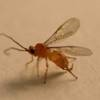Abstract
Doryctobracon areolatus was introduced into Florida and the Dominican Republic for control of the Caribbean fruit fly and the West Indian fruit fly. In its native habitats, parasitism of fruit flies in certain fruit can reach more than 80%. Mean parasitism of Caribbean fruit fly following original establishment in Florida was around 40%. This 4-page fact sheet was written by Charles Stuhl and John Sivinski, and published by the UF Department of Entomology and Nematology, June 2012.
References
Aluja M, Piñero J, López J, Ruiz C, Zuniga A, Piedra E, Díaz-Fleischer F, Sivinski J. 2000. New host plant and distribution records in Mexico for Anastrepha spp., Toxotrypana curvicauda Gerstacker, Rhagoletis zoqui Bush, Rhagoletis sp., and Hexachaeta spp (Diptera : Tephritidae). Proceedings of the Entomological Society of Washington 102: 802-815.
Aluja M, Rull J, Sivinski J, Norrbom L, Wharton RA, Macías-Ordoñez R, Díaz-Fleischer F, López M. 2003. Fruit flies of the genus Anastrepha (Diptera: Tephritidae) and associated native parasitoids (Hymenoptera) in the tropical rainforest biosphere reserve of Montes Azules, Chiapas, Mexico. Environmental Entomology 32: 1377-1385. https://doi.org/10.1603/0046-225X-32.6.1377
Baranowski R, Swanson R. 1970. Introduction of Parachasma (=Opius) cereus (Hymenoptera: Braconidae) into Florida as a parasite of Anastrepha suspensa (Diptera: Tephritidae). Florida Entomologist 53: 161-162. https://doi.org/10.2307/3493363
Baranowski R, Glenn H, Sivinski J. 1993. Biological control of the Caribbean fruit fly (Diptera, Tephritidae). Florida Entomologist 76: 245-251. https://doi.org/10.2307/3495721
Eitam A, Sivinski J, Holler T, Aluja M. 2004. Biogeography of braconid parasitoids of the Caribbean fruit fly (Diptera: Tephritidae) in Florida. Annals of the Entomological Society of America 97: 928-939. https://doi.org/10.1603/0013-8746(2004)097[0928:BOBPOT]2.0.CO;2
Gahan AB. 1919. Descriptions of seven new species of Opius (Hymenoptera-Braconidae) Proceedings of the Entomological Society of Washington 21: 161-170.
López M, Aluja M, Sivinski J. 1999. Hymenopterous larval pupal and pupal parasitoids of Anastrepha flies (Diptera: Tephritidae) in Mexico. Biological Control 15: 119-129. https://doi.org/10.1006/bcon.1999.0711
Ovruski S, Aluja M, Sivinski J, Wharton R. 2000. Hymenopteran parasitoids of fruit-infesting Tephritidae (Diptera) in Latin America and the southern United States: Diversity, distribution, taxonomic status and their use in fruit fly biological control. Integrated Pest Management Review 5: 81-107. https://doi.org/10.1023/A:1009652431251
Serra A, Ferreira M, García S, Santana L, Castillo M, Nolasco C, Morales P, Holler T, Roda A, Aluja M, Sivinski J. 2011. Establishment of the West Indian fruit fly (Diptera: Tephritidae) parasitoid Doryctobracon areolatus (Hymenoptera: Braconidae) in the Dominican Republic. Florida Entomologist 94: 809-816. https://doi.org/10.1653/024.094.0412
Sivinski J, Aluja M. 2003. The evolution of ovipositor length in the parasitic Hymenoptera and the search for predictability in biological control. Florida Entomologist 86: 143-150. https://doi.org/10.1653/0015-4040(2003)086[0143:TEOOLI]2.0.CO;2
Sivinski J, Aluja M. López M. 1997. Spatial and temporal distributions of parasitoids of Mexican Anastrepha species (Diptera: Tephritidae) within the canopies of fruit trees. Annals of the Entomological Society of America 90: 604-618. https://doi.org/10.1093/aesa/90.5.604
Sivinski J, Vulinec K, Aluja M. 2001. Ovipositor length in a guild of parasitoids (Hymenoptera: Braconidae) attacking Anastrepha spp. fruit flies (Diptera: Tephritidae) in southern Mexico. Annals of the Entomological Society of America 94: 886-895. https://doi.org/10.1603/0013-8746(2001)094[0886:OLIAGO]2.0.CO;2
Sivinski J, Rendón P, Holler T, Bloem K, Martínez A, López Valenzuela M. 2000. Distribution of hymenopterous parasitoids of Anastrepha spp. in guava (Psidium guajava) along an altitudinal transect in the Soconusco region (Chiapas, Mexico): practical implications for a potential augmentative biocontrol program with native parasitoids, pp: 115-116. In 4th Meeting of the Working Group on Fruit Flies of the Western Hemisphere, Mendoza, Argentina, Nov. 25-30.
Stuhl C, Cicero L, Sivinski J, Teal P, Lapointe S., Paranhos B, Aluja M. 2011a. Longevity of multiple species of tephritid (Diptera) fruit fly parasitoids (Hymenoptera: Braconidae: Opiinae) provided exotic and sympatric-fruit based diets. Journal of Insect Physiology 57: 1463-1470. https://doi.org/10.1016/j.jinsphys.2011.07.015
Stuhl C, Sivinski J, Teal P, Paranhos B. Aluja M. 2011b. A compound produced by fruigivorous Tephritidae (Diptera) larvae promotes oviposition behavior by the biological control agent Diachasmimorpha longicaudata (Hymenoptera: Braconidae). Environmental Entomology 40: 727-736. https://doi.org/10.1603/EN10198
Wharton RA, Marsh PM. 1978. New world Opiinae (Hymenoptera: Braconidae) parasitic on Tephritidae (Diptera). Journal of the Washington Academy of Science 68: 147-167.

